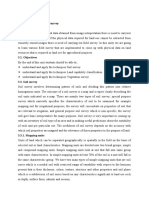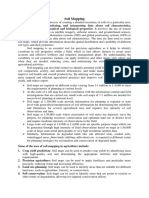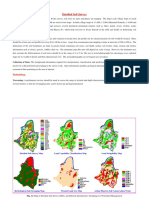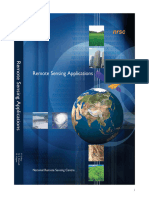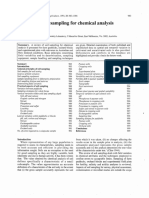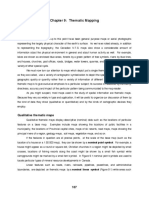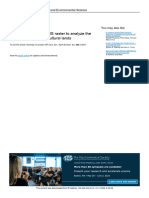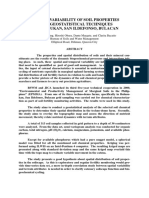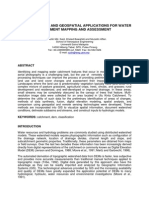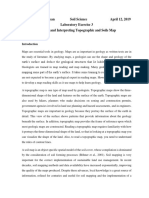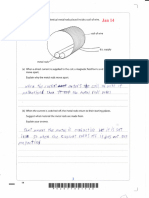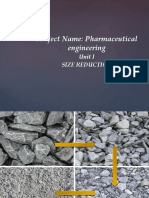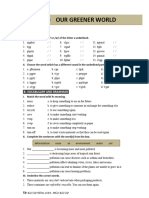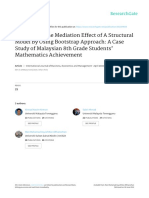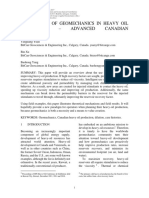LECTURE14- SOIL MAPPING AND FERTILIZER RECOMMENDATION USING
REMOTE SENSING & GIS
The database required for Farm-Level Planning can be obtained by carrying out detailed
characterization and mapping of all the existing land resources like soils, climate, water,
minerals and rocks, vegetation, crops, land use pattern, socio-economic conditions,
infrastructure, marketing facilities and various schemes and developmental works of the
government. From the data collected at farm level, the problems and potentials of the area
can be highlighted, conservation measures required for the area can be indicated,
suitability of the area for various uses can be worked out and finally viable and sustainable
land use options suitable for each and every land holding can be prescribed to the farmer
and other land users of the area. The soil survey are of different types based on the level
of mapping and the required details,
1. Detailed Soil Survey (Conventional method)
Detailed Soil Survey (usually at 1:4000; 1:5000; 1:8000 or 1:10,000 scales) provides the
information necessary to identify homogeneous management units in the field at village
level. The methodology followed in the field and laboratory is briefly indicated below.
1.1 Base Maps Used
The detailed survey of the villages can be carried out by using cadastral maps as a base. The cadastral map
shows all the field boundaries with their survey numbers, location of tanks, streams and other permanent
features of the area.
Remote sensing data products (1:12,500 scale) were used in conjunction with the cadastral
maps to identify the landforms and surface features of the area. The Imageries helped in
the delineation of the boundary between the uplands and lowlands, water bodies, forest
and vegetated areas, salt affected lands, roads, habitations and other cultural features of
the area.
Survey of India toposheets at 1:50,000 scale can be also used as a base for initial traversing, identification of
geology and landform, drainage features, present land use and for the selection of transects at block level.
�1.2 Field Investigation
Preliminary traverse can be carried out by using 1:50,000 scale toposheets. During the traverse, geological
formations, drainage patterns, surface features, slope characteristics, types of land use and landforms were
identified.
In the selected transect, profiles can be located at closely spaced intervals to take care of
any change in the land features like break in slope, erosion, gravel, stones etc. In the
selected sites, profiles (vertical cut showing the soil layers from the surface to the rock)
were opened up to 200 cm or to the depth limited by rock or hard substratum and studied in detail for all
their morphological and physical characteristics. The soil and site characteristics can be recorded for all
profile sites on a standard proforma.
Based on the soil-site characteristics, the soils were grouped into different soil series (soil
series is the most homogeneous unit having similar horizons and properties and behaves
similarly for a given level of management). Soil depth, texture, colour, amount and nature
of gravel present, calcareousness, presence of limestone, nature of substratum and horizon
sequence were the major identifying characteristics of soil series in the area. Phases of
soil series (phase is a subdivision of a soil series based mostly on surface features that
affect its use and management. For example, slope, texture, erosion and stoniness) were
separated and their boundaries delineated on the cadastral maps based on the variations
observed in the surface texture, slope, erosion, presence of gravels, salinity, sodicity etc.
The delineated mapping units occurring in each village are shown on the soil map in the
form of symbols. In arriving the phases, a combination of letters, both in upper and lower
case, and numerals were used. For example, the map unit SvcB3 occurring in Illuppakudi
village is a phase of Sivagangai series. In this, the first two letters indicate the name of the
soil series, the third lower case letter indicates the texture of the surface soil, the fourth
upper case indicates the slope of the land and the fifth numeral indicates the severity of
the soil erosion.
Similarly other features like gravelliness, salinity, sodicity, etc which affects the use of the land can be
indicated in phases. Wherever gravelly phase occurs, the upper case letter G follows the name of soil series
in the third position
�1.3 Laboratory analysis
For the soil series identified, soil samples has to be collected from representative pedons for laboratory
analysis. The soil samples are to be analysed for various physio, chemical characteristics by following
standard procedures.
1.4 Finalisation of Soil Maps
The soil map for each village can be finalized in the field itself after thorough checking of soil and site
characteristics. The village soil maps can be generated using GIS without any generalization and loss of
information and presented for each village separately.
From the village maps, the soil map of the Block can be prepared by combining all the soil maps of the
villages through the use of GIS software. Since the village maps were at larger scale with phases as mapping
units, they were subjected to both cartographic and categorical generalization to prepare the soil map of the
block.
1.5 Generation of Thematic Maps
The soil map and other resources database can be interpreted for identifying the
constraints and potentials, and evaluated for land capability, land irrigability, fertility
capability and land suitability for various crops and other uses for each village separately
by using GIS software.
By using thematic information table for all the mapping units occurring in a village, required thematic
maps can be generated by using GIS software at any time based on the needs of the farmers or any other
users.
The major problem faced in conventional soil survey and cartography is the accurate delineation
of boundary. Field observations based on conventional soil survey are tedious and time consuming. The
remote sensing data in conjunction with ancillary data provide the best alternative, with a better delineation
of soil mapping units (Karale 1992; Kudrat et al.,1990; 1992; Mulders & Epema 1986; Sehgal 1995).
Soil surveyors consider the topographic variation as the basis for depicting the soil
variability. Even with the aerial photographs only physiographic variation in terms of
slope, aspects and land forms are identified for delineating the soil boundary. Multispectral
satellite data are being used for mapping soil up to family association level (1:50,000). The
methodology in most of the cases involves visual interpretation (Karale et al., 1981).
However, computer aided digital image processing technique has also been used for
�mapping soil (Epema 1986; Korolyuk & Sheherbenko 1994; Kudrat et al., 1990) and
advocated to be a potential tool (Kudrat et al., 1992; Lee et al., 1988).
2 Visual image interpretation
Visual interpretation is based on shape, size, tone, shadow, texture, pattern, site and
association. This has the advantage of being relatively simple and inexpensive. Soil
mapping needs identification of a number of elements. The elements which are of major
importance for soil survey are land type, vegetation, landuse, slope and relief. Soils are
surveyed and mapped, following a 3 tier approach, comprising interpretation of remote
sensing imagery and/or aerial photograph (Mulder 1987), field survey (including
laboratory analysis of soil samples) and cartography (the art and science of map
making)(Sehgal et al., 1989). Several workers (Karale 1992; Kudrat & Saha 1993; Kudrat et
al. 1990; Sehgal 1995) have concluded that the technology of remote sensing provides
better efficiency than the conventional soil survey methods (USDA 1951) at the
reconnaissance (1:50,000) and detailed (1:10,000) scale of mapping (Figure 14.1).
3 Computer-aided approach
Numerical analysis of remote sensing data utilizing the computers has been developed
because of requirement to analyze faster and extract information from the large quantities
of data. The computer aided techniques utilize the spectral variations for classification.
The pattern recognition in remote sensing assists in identification of homogeneous areas,
which can be used as a base for carrying out detailed field investigations, and generating
models between remote sensing and field parameters. However, there is a need to have
an automated method for accurate soil boundary delineation with a transdisciplinary and
integrated approach (Figure 14.2).
� Satellite data (summer /
rabi season) Ancillary data (SOI toposheets,
published maps on geology / soil /
reports / meterological data)
Georeferencing and base map
preparation
Physiographic analysis, selection of sample strips and
development of tentative legend
Ground truth collection (Profile / auger
bore studies & collection of soil samples)
Soil Chemical Analysis
Soil Classification
Finalization of soil map
Generation of soil quality maps &
Validation
derivative maps ( LCC, LIC, etc)
Figure 14.1 Methodology for soil mapping through visual interpretation approach
� Remote Sensing Data Toposheets
Physiographic Units
(based on diversity of cover,
erosion and drainage)
Selection of Profile sites
Ground truth Data
Supervised
Classification
Soil Profile Study Chemical Analysis
Merging of Classified
training sets
Classification and Existing
Correlation of Soils Literatures
Mapping Units
Soil Map
(Associations)
Figure 14.2 Methodology for soil mapping through computer aided approach
4 Fertilizer Recommendation Tool
The database generated from the above soil mapping process can be linked and integrated
with a software tool called ‘Fertilizer recommendation tool’ to generate soil and crop
specific fertilizer recommendation based on well-established mathematical functions
(Mitscherlich-Bray approach). The major factors to be considered are soil fertility levels
(macro nutrients like N, P & K and micro nutrients like zinc, copper, manganese and Iron)
and soil problems like sodicity and calcarousness. The parameters viz., doses of
nitrogenous, phosphatic and potassium fertilizers based on the type of crop and area of
crops to be cultivated.
This information are useful for the farmers, extension workers, crop advisors, and also the researchers.
The data base includes soil survey details, soil analytical data and crop suitability and are available for each
survey number on the village map.


